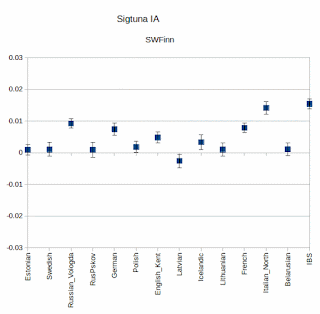Following the idea presented in my previous post, I compared in a wide picture the common genetic drift between modern Europeans and those loosely understood Viking groups reported in my mytrueancestry.com results. Before 3Pop-analyses something has to be done, all snp-sets has to be standardized. I can guarantee that if you put data sets into analysis at random you will get simply garbage. Actually also Dstat calls for extra attention, but especially 3Pop is a pitfall if you have not done any pre-analysis. Even though in my previous Dstat I was able to use commercial Finnish groups without data standardization, the same wouldn't work with 3Pop. To get a valid Finnish samples representing Southwestern Finns and covering the Human Origin data set, I made a 3Pop-pre-analysis selecting best 1000genomes samples corresponding my genealogically confirmed project samples.
Oeselian samples:
X04 dated 420BC
V12 dated 215BC
Thursday, January 23, 2020
Wednesday, January 22, 2020
Trans-Volga Forest Steppes CWC and Finns
This topic became into my mind after seeing my personal results provided by a new service, mytrueancestry.com. Without judging what they do I simply borrow some of their ideas based on my results. I see three components they propose to me
- Trans-Volga Forest Steppes CWC
bns023,btm021,grt035,grt036,gtm127,kal006,kal009,kls001,nuf002,stg020,stg021,stg026,t2072,
Langobards/Lombards
Szolad, Hungary. Graves dated to the middle of the sixth century. Two samples SZ4 and SZ16.
Bolshoy Oleni Ostrov
Five samples dated around 3500BP, with high Siberian admixture and carrying N-L392/N-L1026 male haplotype.
For comparison Iberian Bell-Beaker samples.
In following statistics positive numbers stand for more similarity between Finnish groups and ancient samples, negative values more similarity between other Europeans and ancient samples.
We see that Swedes and Latvians fit well with Lombards, but Alemannic people only with Latvians, the Latvians being a top match. Trans-Volga CWC and Sigtuna fits well with Finns and Latvians and best with Latvians. Actually Sigtuna IA is a bit closer Southwest Finns than two Swedish Human Origin samples. Bolshoy Oleni Ostrov samples are strongly related to Finns, even so that East Finns are closer BOO samples than Southwestern Finns, despite the fact that in my results Levaluhta samples are closer Southwestern Finns. Iberian BB doesn't fit well with present-day Iberians (1000genomes IBS).
edit 23.1.20 15:00
Added dstat-analyses showing Western Finnish Iron Age Saami results (Levaluhta). Both Finnish groups are top matches, followed by Swedish and Latvian sample groups.
- Trans-Volga Forest Steppes CWC
- Viking Sweden
- Medieval Oeselian Saaremaa
Additionally the analysis included two Iron Age Germanic speaker groups: Allemannic and Lombardic groups. Their method searches IBD similarity between customer data and ancient samples. No process description is available, so I can't say much more about it. My following tests show Dstat-similarity comparing two Finnish groups, Southwest and East Finns, to present-day Europeans in comparison to those ancient samples. This time I used Finnish samples from my own project and all samples are confirmed by genealogical research and are not defined by any approximation using 1000genomes data.
Ancient data:
Trans-Volga_Forest_Steppes_CWC
kzb002,kzb006,kzb007,kzb008,kzb009
Sigtuna
bns023,btm021,grt035,grt036,gtm127,kal006,kal009,kls001,nuf002,stg020,stg021,stg026,t2072,
t84001,t84005,t84035,t97002,t97026,t97029,urm035,urm045,urm160,urm161
Alemanni
The 7th century Alemannic burial site at Niederstotzingen in southern Germany, used from 580 to 630 AD. 13 human skeletal remains, 10 adults and 3 infants. 10 adult samples used.
Langobards/Lombards
Szolad, Hungary. Graves dated to the middle of the sixth century. Two samples SZ4 and SZ16.
Bolshoy Oleni Ostrov
Five samples dated around 3500BP, with high Siberian admixture and carrying N-L392/N-L1026 male haplotype.
For comparison Iberian Bell-Beaker samples.
In following statistics positive numbers stand for more similarity between Finnish groups and ancient samples, negative values more similarity between other Europeans and ancient samples.
We see that Swedes and Latvians fit well with Lombards, but Alemannic people only with Latvians, the Latvians being a top match. Trans-Volga CWC and Sigtuna fits well with Finns and Latvians and best with Latvians. Actually Sigtuna IA is a bit closer Southwest Finns than two Swedish Human Origin samples. Bolshoy Oleni Ostrov samples are strongly related to Finns, even so that East Finns are closer BOO samples than Southwestern Finns, despite the fact that in my results Levaluhta samples are closer Southwestern Finns. Iberian BB doesn't fit well with present-day Iberians (1000genomes IBS).
Added dstat-analyses showing Western Finnish Iron Age Saami results (Levaluhta). Both Finnish groups are top matches, followed by Swedish and Latvian sample groups.
Subscribe to:
Posts (Atom)

















